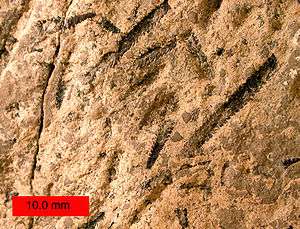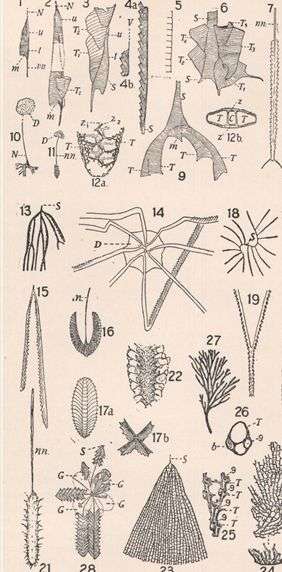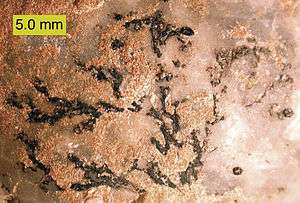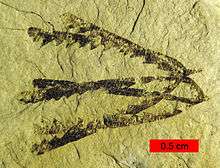Graptolithina
| Graptolites Temporal range: Mid Cambrian to Carboniferous,[1] | |
|---|---|
 | |
| Amplexograptus from the Ordovician near Caney Springs, Tennessee. | |
| Scientific classification | |
| Kingdom: | Animalia |
| Phylum: | Hemichordata |
| Class: | †Graptolithina |
| Orders | |
| |
Graptolithina is a class of hemichordate animal, the members of which are known as graptolites. Graptolites are fossil colonial animals known chiefly from the Upper Cambrian through the Lower Carboniferous (Mississippian). A possible early graptolite, Chaunograptus, is known from the Middle Cambrian.
The name graptolite comes from the Greek graptos, meaning "written", and lithos, meaning "rock", as many graptolite fossils resemble hieroglyphs written on the rock. Linnaeus originally regarded them as 'pictures resembling fossils' rather than true fossils, though later workers supposed them to be related to the hydrozoans. More recent work places them near the pterobranchs, possibly within.[2]
One analysis suggests that the Pterobranchia represent extant graptolites.[3]
Taxonomy
The name "graptolite" originates from the genus Graptolithus, which was used by Linnaeus in 1735 for inorganic mineralizations and crustations which resembled actual fossils. In 1768, in the 12th volume of Systema Naturae, he included G. sagittarius and G. scalaris, respectively a possible plant fossil and a possible graptolite. In his 1751 Skånska Resa, he included a figure of a "fossil or graptolite of a strange kind" currently thought to be a type of Climacograptus (a genus of biserial graptolites). Later workers used the name to refer to a specific group of organisms. Graptolithus was officially abandoned in 1954 by the ICZN, partly because of its original purpose as a grouping for inorganic mimicries of fossils. (Bulman, 1970: V 6)
Since the 1970s, as a result of advances in electron microscopy, graptolites have generally been thought to be most closely allied to the pterobranchs, a rare group of modern marine animals belonging to the phylum Hemichordata (hemichordates). Comparisons are drawn with the modern hemichordates Cephalodiscus and Rhabdopleura.[2] Cephalodiscus numbers about 18 species, and was first discovered in 1882.
Graptolites as index fossils
Graptolites are common fossils and have a worldwide distribution. The preservation, quantity and gradual change over a geologic time scale of graptolites allows the fossils to be used to date strata of rocks throughout the world.[2] They are important index fossils for dating Palaeozoic rocks as they evolved rapidly with time and formed many different species. British geologists can divide the rocks of the Ordovician and Silurian periods into graptolite biozones; these are generally less than one million years in duration. A worldwide ice age at the end of the Ordovician eliminated most graptolites except the neograptines. Diversification from the neograptines that survived the Ordovician glaciation began around 2 million years later.
Graptolites are also used to estimate water depth and temperature during the graptolites lifetimes.
 | |
| Ranges of Graptolite taxa. | |
Morphology


Each graptolite colony is known as a rhabdosome and has a variable number of branches (called stipes) originating from an initial individual (called a sicula). Each subsequent individual (zooid) is housed within a tubular or cup-like structure (called a theca). In some colonies, there are two sizes of theca, and it has been suggested that this difference is due to sexual dimorphism. The number of branches and the arrangement of the thecae are important features in the identification of graptolite fossils. Their general shape has been compared with that of a hacksaw blade.
Most of the dendritic or many-branched types are classified as dendroid graptolites (order Dendroidea). They appear earlier in the fossil record (in the Cambrian period), and were generally sessile animals (attached to the sea-floor by a root-like base). Graptolites with relatively few branches were derived from the dendroid graptolites at the beginning of the Ordovician period. This latter type (order Graptoloidea) were pelagic and planktonic; drifting freely on the surface of ancient seas or attached to floating seaweed by means of a slender thread. They were a successful and prolific group, being the most important animal members of the plankton until they died out in the early part of the Devonian period. The dendroid graptolites survived until the Carboniferous period.
Preservation
Graptolite fossils are often found in shales and mud rocks where sea-bed fossils are rare, this type of rock having formed from sediment deposited in relatively deep water that had poor bottom circulation, was deficient in oxygen, and had no scavengers. The dead planktonic graptolites, having sunk to the sea-floor, would eventually become entombed in the sediment and are thus well preserved.
Graptolites are also found in limestones and cherts, but generally these rocks were deposited in conditions which were more favorable for bottom-dwelling life, including scavengers, and undoubtedly most graptolite remains deposited here were generally eaten by other animals.
Graptolite fossils are often found flattened along the bedding plane of the rocks in which they occur, though may be found in three dimensions when they are infilled by iron pyrite. They vary in shape, but are most commonly dendritic or branching (such as Dictyonema), saw-blade like, or "tuning fork" shaped (such as Didymograptus murchisoni). Their remains may be mistaken for fossil plants by the casual observer.
Graptolites are normally preserved as a black carbon film on the rock's surface or as light grey clay films in tectonically distorted rocks. The fossil can also appear stretched or distorted. This is due to the strata (that the graptolite is within) being folded and compacted. They may be sometimes difficult to see, but by slanting the specimen to the light they reveal themselves as a shiny marking. Pyritized graptolite fossils are also found.
A well known locality for graptolite fossils in Britain is Abereiddy Bay, Dyfed, Wales, where they occur in rocks from the Ordovician period. Sites in the Southern Uplands of Scotland, the Lake District and Welsh Borders also yield rich and well-preserved graptolite faunas.
Footnotes
- ↑ http://commonfossilsofoklahoma.snomnh.ou.edu/graptolites
- 1 2 3 Fortey, Richard A. (1998). Life: A Natural History of the First Four Billion Years of Life on Earth. New York: Alfred A. Knopf. p. 129. ISBN 0-375-40119-9.
- ↑ Mitchell, C. E.; Melchin, M. J.; Cameron, C. B.; Maletz, J. R. (2012). "Phylogenetic analysis reveals that Rhabdopleura is an extant graptolite". Lethaia: no. doi:10.1111/j.1502-3931.2012.00319.x.
References
Bulman, 1970. In Teichert, C. (ed.). Treatise on Invertebrate Paleontology. Part V. Graptolithina, with sections on Enteropneusta and Pterobranchia. (2nd Edition). Geological Society of America and University of Kansas Press, Boulder, Colorado and Lawrence, Kansas, xxxii + 163 pp.
Jaroslav Kraft, Czech palaeontologist and a specialist in dendroid graptolites
Bibliography
- Kolbert, Elizabeth - The sixth extinction, an unnatural history - Henry Holt, USA 2014 - ISBN 978-0-8050-9299-8
External links
 Data related to Graptolithina at Wikispecies
Data related to Graptolithina at Wikispecies- Classification of the Cephalodiscoidea (Graptolithoidea) - Graptolite.net - Cephalodiscus
- BIG G - The British & Irish Graptolite Group - British and Irish Graptolite Group (BIG-G)
- What is a Graptolite? From the Research Website of David Bapst - What is a Graptolite?
- Graptolite photos Graptolites. retrieved 2012-02-10.
| Wikimedia Commons has media related to Graptolithina. |

